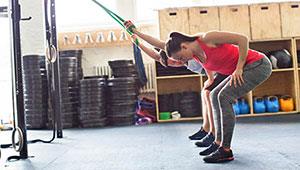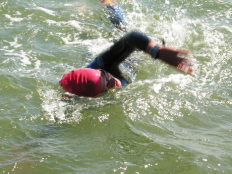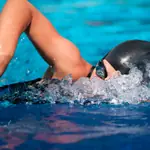Lower Back Pain
Lower back injuries, which are oftentimes associated with the butterfly stroke, keep many swimmers out of the water. As swimmers rise out of the water and arch their backs during the butterfly, pressure is put on the lumbar vertebrae. Soreness in the lower back, stiffness and swelling usually accompany this issue.
More: How Yoga Can Help your Lower Back Pain
Treatments:
- Rest for two to three days and limit the amount of training you devote to the butterfly stroke;
- Heat the affected area to help the lower back muscles relax.
Prevention:
- Strengthen back muscles to take pressure off the spine by completing squat and dead lift exercises;
- Keep your back flexible by stretching after every workout
Breast Stroke Swimmer's Knee
Creating pain on the inner side of the knee, breast stroke knee is usually a result of poor technique.
"With breast stroke you do the whip kick, so as you internally rotate your hips with a bent knee and hips, you turn your feet out, which can be hard on the medial knee," Leisz says.
More: Avoiding Shoulder Swimming Injuries
Pain increases as you continue to do the whip kick and will generally be tender and sometimes swollen following exercise.
Treatment:
- Switch to other strokes allowing the major knee ligaments to heal;
- Ice the medial knee for 10 minutes twice daily, especially following exercise.
Prevention:
- Be sure to warm up and cool down before and after workouts;
- Maintain variety in the different strokes you practice in order to avoid the repetitive stress to the same soft tissues;
- Avoid excessive rotation of the hips in training.
Neck Injuries
The high head position required during swimming can cause a host of issues for recreational and competitive swimmers alike. Whether you are lifting your head out of the water or rotating it sideways to take a breath, these repetitive motions can lead to chronic pain.
Treatment:
- Take several days out of the pool and substitute with cardio dryland training;
- Stretch your neck and shoulders several times a day to loosen the surrounding musculature.
Prevention:
- Strengthen the neck muscles by completing neck extension and shoulder roll exercises;
- Work on your form during flip turns to avoid over-extension.
More: Exercises to Prevent Swimmer's Shoulder
 Search for your next triathlon.
Search for your next triathlon.
- 2
- of
- 2
About the Author

Get ACTIVE on the Go


Meet Mobile
Swim smarter: heats, lane assignments and real-time results in the palm of your hand.
Available for iOS | Android







Discuss This Article